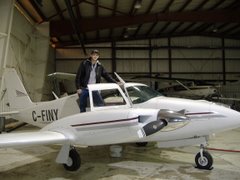There's two techniques you can use to correct this: The crab method and the wing low method. The crab method is much more difficult and requires precise timing with small aircraft (larger jets have a better time using this), so it is not often used. The wing low method is mainly what is being taught for light aircraft, so that is the method I'll explain.
To align the wheels when landing using the wing low method requires the use of both aileron and rudder. You use the
 ailerons to bank into the wind, and then opposite rudder to align the nose with the runway. This results in the upwind wing being slightly lower then the other one, which also means that the upwind wheel will touch down first. Naturally the stronger the crosswind the more crosswind correction is required, and the more difficult it becomes.
ailerons to bank into the wind, and then opposite rudder to align the nose with the runway. This results in the upwind wing being slightly lower then the other one, which also means that the upwind wheel will touch down first. Naturally the stronger the crosswind the more crosswind correction is required, and the more difficult it becomes.Today I went up for another lesson in the Twin Comanche. We just reviewed the usuals: steep turns, engine failure in cruise, and engine failure in the overshoot. We also did some circuits, and the air was incredibly bumpy, and the crosswind was nuts too. We were using runway 27 with the winds at 230° at 22 kts gusting to 27. That works out to about a 14 to 17 knot crosswind. Officially the strongest crosswind I've ever flown in. The crosswinds were just about at my personal limits, and they were just on the verge of the airplane's limits too. Richard said I did very well. One landing I had to use full rudder deflection to keep the wheels straight and tracking the runway as we touched down, and it was difficult to maintain directional control after touchdown before we had slowed completely as well. I wouldn't call those crosswind conditions fun, but they were certainly a challenge I was glad I took on. It was quite the adrenaline rush.
With gusty conditions it is impossible to hold the nose steadily aligned with the runway, so timing becomes more critical as you try to touch down at the moment the nose is aligned properly. Your feet are on the rudder pedals kicking back and forth trying to counteract the wind gusts, your right hand is ready on the throttles, and the left hand is on the yoke working the ailerons opposite to rudder direction and making pitch adjustments to keep the airplane in the flare ready to touch down as soon as the nose is straight. Its important that we don't let the airplane touch down until the wheels are aligned with the direction of motion, and its tricky when the wind gusts are blowing the nose back and forth. Quite the challenge, but those are the moments pilots live for - to conquer the airplane even when the elements turn against us.




So, would this explain when I'm on a commercial aircraft and one wheel touches down before the other? If so, we can assume when this happens there is a sizeable cross wind. Or do all commercial aircraft use the crab technique and this doesn't happen? Or is this sometimes just lousy piloting?
ReplyDeleteI think most larger aircraft use the crab technique, or maybe a combination of the crab technique and the wind low method if the timing ends up to not be perfect. The crab technique involves flying the airplane down "crabbed" into the wind and then at the last second before touchdown use the rudder to swing the nose straight before the wheels contact the pavement. Once you've swung nose around straight you need to make sure you touch down before the airplane is aloud to be blown sideways downwind. Crabbing is easier in a larger airplane because the mass of the aircraft means it will have more momentum, and will continue to travel down the runway in the original direction after the nose has been swung straight. If their timing is off and they swing the nose too early, the fastest way to correct that is to bank into the wind (turning it into a wing low method), thus landing on the upwind wheel first. Does that make it lousy piloting? You decide. They didn't accomplish the technique to perfection but they did what they needed to do to land the airplane with the wheels straight. Its difficult to explain the whole process with words, take a look at these videos. In the first video watch the pilots kick over the nose so its aligned with the runway before it touches down. Great job.
ReplyDeletehttp://youtube.com/watch?v=kRCsbMe3_Ao
This is a video of Boeing test pilots testing the crosswind limits of the 777. Not a very good demostration of proper technique (just because they're purposely stressing the airplane), but REALLY cool nonetheless.
http://youtube.com/watch?v=ljOxo0s33sI